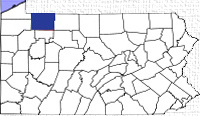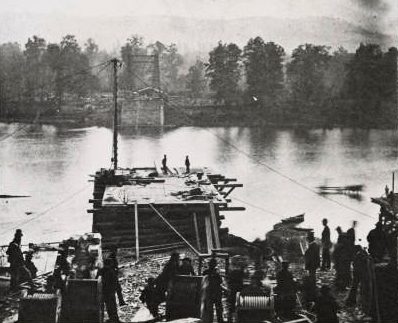

 |
 |
 |
||
Part of the PAGenWeb Project |
||||
Transcribed extractions from a newspaper published in Warren.
Names are in bold for ease in finding them.
LINKS:
(edition was eight pages in length; account of the bridge was on page 5, columns 2-3)
OLD BRIDGE BEING DISMANTELED
HAS QUAINT HISTORY WITH SIDE LIGHTS OF PIONEER BRILLIANCE
Has Accommodated Thousands in Pilgrimage to Oakland Cemetery, City of Dead; Its Relation to the Old Raftsmen
SILHOUETTE ON RIVER TO VANISH
The expression "Well Done Thou Good and faithful Servant" is applicable to the stately old bridge which for almost a half century has weathered the elements and borne the traffic of this and adjoining communities. The work of dismantling is progressing rapidly and soon the structure will be naught but a memory.
The bridge was built upon honor in 1871 by John R. Roebling, Jr., a son of the famous old bridge builder who learned the art of bridge designing and construction in Prussia.
| Construction of the suspension bridge across the Allegheny River in Warren in 1871. View is to the south. |
 |
| Photo courtesy of the Warren Library Association |
| While the photographer is listed as unknown, this could be the photograph taken by William Kitchen (see below). |
Sihloutte [sic] on River Bosom.
For years the graceful outlines has attracted the eye of the stranger within our gates. No more the silhoutte upon the bosom of the beautiful Allegheny at night, no more the moaning and creaking of the timbers in time of tempest.
Its history is on [sic] of joy and also of sadness. A quarter of a century ago multitudes crossed to attend the ball games, races and county fair but it served its greatest mission, however, in accommodating the countless thousands who were want to make pilgrimage to Oakland, the silent city of the dead, burdened with with [sic] flowers to place upon the mounds of those near and dear who have crossed the river and sleep beneath the trees.
Printz Shows Good Photo.
There was on exhibition in one of the store windows of A. A. Printz a photograph showing the workmen engaged in building the abutments of the bridge forty eight years ago. This is quite a curiosity and was taken by William Kitchen who for many years was a photographer. He continued in business in Warren until about 30 years ago and was the father of James Kitchen of the Pennsylvania Gas company.
Warren a Supply Depot.
Warren in those days was a depot of supplies for the lumbering camps located on all the streams. The Jacksons, Halls, Irvines, Meads McLinneys and Hooks were busy turning the noble pines into lumber, and our merchants were generally dealers in lumber as well. As the spring rains raised the streams the lumber floated to Warren from the upper Allegheny and Conewango and was here "coupled up" into the regulation "Allegheny Fleet". The Allegheny was a scene of noisy activity and the streets were filled with raftsmen, many of them somewhat more than "gentlemanly Gay" with whiskey which was plenty enough in those days. Seneca Burgess had a store about where the Warren National Bank is now located and a sign with bold letters which advertised groceries and licquor [sic].
At times one could almost cross the river on the rafts and below would be filled.
Hemlock at $5.
At that time hemlock lumber sold for $5.00 the thousand and it was not uncommon to see a million feet of lumber tied up at one time near the bridge one can realize realize [sic] what the lumber industry was to Warren in the early days. At the price of what lumber is today its value would be several millions of dollars annually. The lumbermen usually looked for a June rafting stage and in the Spring it was not unusual for pilots to make three and four trips to the southern markets.
| Looking from Pennsylvania Avenue at Hickory Street to the south. Brick structure on the left is the 1873 tollbooth for the bridge. |
 |
| Photo courtesy of the Warren Library Association |
| Taken about 1890, this picture of rafts at the bridge depicts only a fraction of the lumber floated in the 1870s. |
"Old Guy" Conspicuous.
Among the lumberman [sic] of conspicuous figure was Guy C. Irvine, of Irvineburg, on the Conewango. "Old Guy" as his familiars called him was one of the largest operators on the river, "rough and tough" like Joey B. but in his roughness and toughness he was much more dangerous than Dicken's amiable old soldier. The old residents are full of men and the river. It was James Olney, the noted Allegheny pilot, who after examination with the eye of an expert the hull of the steamboat which Jerome W. Wetmore built near Warren to test his idea of a walking boat, gave his opinion to this effect: "With a good ingine, 'n a good starn-wheel 'n a good pilot 'n a plenty of beech wood, she-may-go-down the river, but she'll never come back, never."
Gleaming Ice Cakes Pretty.
When Spring opened and the ice went out of the river of a moonlight night, what a sight it was to see the gleaming cakes mount the pier of the vanished bridge which stood at the foot of Main avenue, south side, and rattle down the boulders, with which it was filled, with a shower of sparks. Then the banks were piled high with grubs and skiffs and oar stems and as the water rose the rafts came down the river until the eddy was solid lumber and the town was filled with noisy and obsterperous raftsmen. The great flood of 1865, the highest ever known, which covered the Irvine flats and scattered Ballard and Company's oil barrels from Warren to Pittsburgh, was a fresh wonder. Some remember the long freshet of 1866, when the concourse of raftsmen, delayed by high water enabled the Rouse and company troupe of actors to play in Johnson's Hall for a whole month to good business, changing the bill nightly, and exhausting the whole range of dramatic linterature [sic] from "Hamlet" and "MacBeth" to "The Ticket of Leave Man" and "Toodles".
Sketch of Oakland.
Reference is made to Oakland cemetery of the silent city of the dead and a short sketch may be of interest to Times readers.
"Warren's burial place is beautiful, Oakland a sightly place on a hill south of Warren. It now contains 83 acres and there are almost 10,000 reposes in eternal rest.
It is a conception of the Odd Fellows and was dedicated in 1865. Had this order never done any other good, this alone would emblem it in the memories of present and future generations. It would seem that Rose Terry Cooke must have visited Warren when she wrote the "Two Villages".
Over the river on the hill
Lieth a village white and still;
All around in the forest trees
Shiver and whisper in the breeze.
Over it, sailling shadows go
Of soaring hawk and screaming crow;
And mountain grasses, low and sweet
Grow in the middle of the street.
In this village under the hill,
When the night is starry and still,
Many a wary soul in prayer
Looking to the village, there,
And weeping and sighing, long to go
Up to that home from this below;
Long to sleep in that forest wild,
Whither our vanished wife and child,
And heareth praying, this answer
fall:
Patience! That village shall hold you all.
(edition was eight pages in length, article below was on page 4)
THREE LOCAL BOYS REPORT FOR SERVICE
Lawrence Pitt, Ray C. Bines and Newman Bright Will Take Course of Army Training At Lehigh College for Electricians.
NO NEW DRAFT CALLS HAVE BEEN RECEIVED.
Three more men were voluntarily inducted into the military service of the United States army yesterday. They were Lawrence Ralph Pitt of Spring Creek; Ray C. Bines of Sheffield and Newman J. Bright of this city.
These young soldiers left last evening for Lehigh College to take up a course of training that will fit them for electricians with the Yankee army.
The local board has received no late calls for men but expects shortly this city's quota in the draft from Pennsylvania authorized for October.
(edition was five pages in length, article below was on page 5)
SPECIAL MEMORIAL SERVICES IN SHEFFIELD IN MEMORY OF SIX BOYS WHO GAVE LIVES IN WAR
Pastor of the Methodist Episcopal Church There Prepares Special Sermon for the Occasion.
Sheffield, Feb. 22--At the Sunday evening service in the Methodist Episcopal church, special Memorial services will be held in memory of six boys who gave their lives in the service of their country. The pastor, Rev. W. J. Small, will have a special sermon for the occasion and special music will be rendered.
Charles F. White, private, Co. A, 49th Infantry, accidently killed in United States, October 17, 1917.
Frank M. Glendenning, Second Lieut., Co. B, 111 Infantry--Former principel [sic] of schools. Killed in action in France, August 12th, 1918, while leading his men toward a German gun nest.
George W. Neaves, private, Co. 13, Bn. 3, Section B. Died of pneumonia in United States, October 17, 1918.
Ray C. Bines, Lehigh University, Camp Copper, South Bethlehem, Pa. Died of pneumonia,October 24, 1918.
R. H. Carr, A. E. F. Died of disease in France.
Oran Kahle. Infantry. Killed in action October 26, 1918.
(edition was five pages in length, article below was on page 4)
Sheffield's Honor Roll.
Following are the names of the Sheffield boys who died in the service of their country:
Charles F. White, private Company A, 49th Infantry, accidently killed at Camp Merritt, October 17, 1917, son of Mr. and Mrs. W. White.
Frank M Clendenning [sic], Second Lieutenant, Co. B, 11th Infantry, son of Mr. and Mrs. Clendenning of Pitcairn, Pa. formerly principal of Sheffield Township schools. Killed in action, August 12, 1918 in France, leading his men toward a German machine gun nest.
George W. Neaves, private in Co. 13, Bn. 3, Section B. died from pneumonia at Camp Greenleaf, October 17, 1918.
Ray C. Bines, died October 24, 1918, from pneumonia at Camp Copper, South Bethlehem, Pa.
Rell [sic s/b Rehl] H. Carr, died from disease in Base Hospital in France October 20th 1918.
Corporal Ora Kaute, Company G, 325th Infantry killed in action in France, October 26th, 1918.
[Warren County coordinator's note: Charles F. White was buried in Sheffield Cemetery, Frank M Glendenning was buried in the Crossroads Cemetery, Allegheny County; George W. Neaves buried at an unknown location; Ray C. Bines buried in Oakland Cemetery; Rehl H. Carr was buried in the Sheffield Cemetery; and Ora Kahle/Kaute - no burial location found]
Return to Warren County newspaper index | Warren County genealogy homepage
A proud participant in the USGenWeb and PAGenWeb Projects